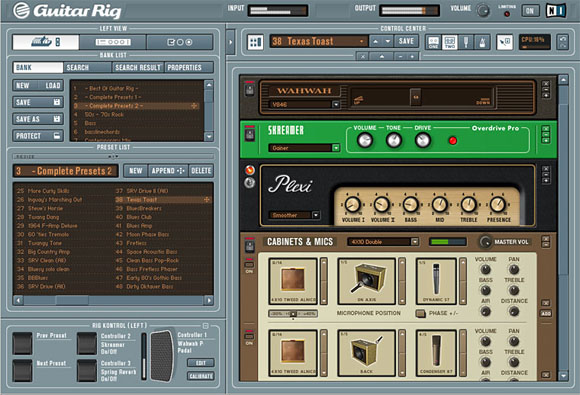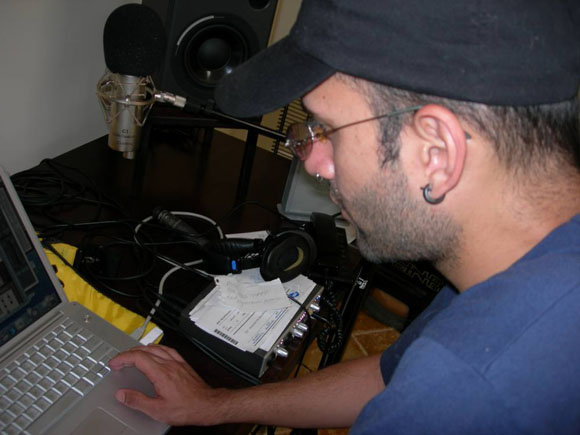
CDM welcomes guest reviewer Pierce Case, who shares his experiences with Native Instruments hardware/software combo for Mac and PC, Guitar Rig. In a first for CDM, we’ve also got sound samples for you to hear. So will Guitar Rig make you replace amps and pedals with software? See what Pierce thinks. (And unlike me, he actually plays the guitar!) -PK
For those looking for a truly unique guitar effect processor, your search may be over. Guitar Rig 1.2 from Native Instruments is an effect processor that feels like using real analog amps and mics.
As a guitarist, I was looking for the best software out there that
would allow me to get those sounds that I wanted without sacrificing quality. I could hardly believe how well Guitar Rig did that. It’s set up with some pretty incredible sounds already
included in the application, with presets, modules, and controllers out of the box.
What it sounds like, how it works: impressions
Guitar Rig lets you adjust placement of mics and amp selections to taste, with up to an impressive five stacks. The physical pedal board controller allows you to have more control over how much wah you want, new sound creation, and many other options. You have two tape machines that allow you to audition play tracks on
the go, a tuner (mute-able, so no one has to know you’re using it), and full editing of presets, including saving on the go.
During a long test period with my loaner from Native
Instruments, I got to really test drive this baby for CDM. Registration was easy via the website, from which you can download of the most current software update. Integration with Logic Pro went smoothly.
Where I ran into trouble was not with Guitar Rig itself but the power of my Mac; you need a powerful machine get the most out of the application. Ideally, you’ll want as much RAM as you can muster and, if possible, even a G5 processor. (Ed: See the extended discussion of system requirements below. -PK) I also had difficulty with presets; on occasions the pedal board would spontaneously switch from one preset to another. Native Instruments’ Gabriel helped me onsite and explained I had connected it incorrectly to my M-
Audio FireWire 410 audio interface; connecting it according to his instructions fixed the problem. (Ed: Native Instruments reports the problem was connecting the Guitar Rig’s audio into the preamps on the 410; using line-level inputs on the back of the interface thus fixed the problem. -PK)

Guitar Rig isn’t necessarily just for guitar players. It can be used with the many instrument and effects plugins in Logic Pro, too, expanding on Logic’s built-in synths. I also experimented with using Guitar Rig with my microphone. It opened up a totally new world of possibilities. You’ll need a full-featured DAW to host Guitar Rig, though; GarageBand support is limited, requiring manual adjustment of parameters. (Ed: To clarify, it is possible to use GarageBand and Guitar Rig together, but functionality is limited by GB’s lack of full control over audio inputs, necessary for controlling Guitar Rig in GarageBand. You can create a GB song, though. -PK)
Which machine do you need?
Pierce’s test machine: Apple PowerBook G4 1.5G with 1G RAM
NI suggested specs:
Bare minimum: 733Ghz – 512MBs Native says these specs will work, but with some minor latency
Recommended: 1.25G G4
Highly Recommended: PowerBook G4 1.67G with 1.5G RAM
Optimal: Power Mac G5 Dual 2.0GHz with 1G of memory. Native says this machine will run just about anything zero-latency — but it’ll be a lot harder to drag to your gig!
Windows systems: Pentium / Athlon XP 1.4 GHz optimal; Pentium 700 MHz / Athlon XP 1.33 GHz, 256 MB RAM bare minimum
Ed’s notes: Hmm, looks like we want those new Intel laptops even sooner. Keep in mind, though, our friend Christopher had good results on a 1.2G Mac Mini; see our report on his Mac Mini rack-mount live setup running Guitar Rig. And even on PC, you’re going to want a pretty decent machine. Your mileage may vary, in other words. Anyone else out there using Guitar Rig want to report on your experience? -PK

Conclusions
As far as sound goes, Guitar Rig is truly amazing. Whether you’re a pro or just an ordinary guitar dude just wanting to rock, you can get the sound you want. Listen to the sample sounds I recorded exclusively for CDM to get an idea of the sounds.
The bottom line is that Guitar Rig delivers incomparable sound. It’s simply that good. And the word of mouth on the
streets about Guitar Rig is impressive. At US$499.00 retail it’s not cheap. But with the pedal board hardware included, it could be exactly what you need to complement your studio.
Pros: Sounds that are hard to match in any other guitar processor. Lots of presets. Can use with your existing plugins and soft synths, with vocals and synth parts. Runs well with Logic Pro and Live. Great tech support.
Cons: Needs a fast machine. Pedal Board integration with M-Audio 410 was initially confusing. Issues with GarageBand (could Apple add additional support, please?)
Pricing: US$499 retail; US$450 street
Compatibility: Mac/Windows
Sound Samples:
Pierce sends some samples of him playing with Guitar Rig — as they say, the proof’s in the pudding. Take a listen to these MP3s and see what you think:
– Guitarist Pierce Case joins CDM as a special guest reviewer for this review.
More on Guitar Rig: See CDM’s special report on a rack-mounted Mac Mini running Guitar Rig live.